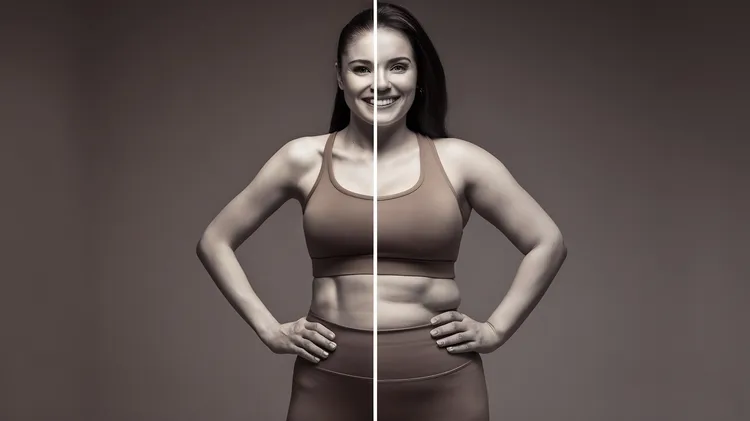Weight Loss vs. Fat Loss: Understanding the Difference for a Healthier You
When it comes to transforming your body, the terms "weight loss" and "fat loss" are often used interchangeably, but they represent fundamentally different goals with distinct impacts on your health, appearance, and overall well-being. While stepping on the scale and seeing a lower number can feel like a victory, it doesn’t always mean you’re losing fat - or improving your health. Whether you’re starting a fitness journey or refining your approach, understanding this difference is key to achieving your goals. Let’s break it down!

What Is Weight Loss?
Weight loss refers to a reduction in your total body weight, which includes fat, muscle, water, bone, and organ mass. When you see the number on the scale drop, it could be due to losing any combination of these components. Weight loss is often the focus of quick-fix diets, crash cleanses, or extreme calorie restriction, but it doesn’t always equate to better health or a leaner physique.
Common Causes of Weight Loss:
- Fat Loss: Burning stored body fat through a calorie deficit or exercise.
- Muscle Loss: Losing muscle tissue due to inadequate protein intake, lack of strength training, or extreme dieting.
- Water Loss: Dehydration from low-carb diets, diuretics, or reduced glycogen stores (glycogen binds water in muscles).
- Glycogen Depletion: Low-carb or fasting diets deplete glycogen, reducing weight without affecting fat.
- Waste Elimination: Temporary weight fluctuations from bowel movements or reduced bloating.
Why Weight Loss Can Be Misleading:
- Short-Term Fluctuations: Water weight can vary by 2-5 pounds daily due to diet, hydration, or hormones, masking true progress.
- Muscle Loss: Crash diets often lead to muscle breakdown, slowing metabolism and making weight regain more likely.
- Lack of Specificity: The scale doesn’t tell you what you’re losing, so a lower number doesn’t guarantee a healthier body composition.
What Is Fat Loss?
Fat loss specifically refers to reducing body fat while preserving or even increasing lean muscle mass. It’s a targeted approach that focuses on improving body composition - lowering your body fat percentage while maintaining muscle, bone, and organ health. Fat loss is associated with long-term health benefits, improved physical performance, and a toned, defined appearance.
Key Characteristics of Fat Loss:
- Targeted: Aims to reduce stored fat (adipose tissue) while preserving muscle.
- Sustainable: Requires a moderate calorie deficit, balanced nutrition, and exercise, leading to lasting results.
- Health-Focused: Improves metabolic health, reduces disease risk (e.g., heart disease, diabetes), and enhances energy levels.
- Appearance-Driven: Results in a leaner, more toned look rather than a “skinny” or depleted appearance.
Why Fat Loss Matters:
- Metabolic Health: Excess body fat, especially visceral fat around organs, is linked to insulin resistance, inflammation, and chronic diseases. Reducing fat improves these markers.
- Muscle Preservation: Maintaining muscle supports a higher metabolism, as muscle burns more calories at rest than fat.
- Aesthetic Goals: Fat loss creates a defined, athletic look, unlike weight loss, which can leave you looking “skinny fat” (low weight but high body fat percentage).
Weight Loss vs. Fat Loss: Key Differences
Aspect | Weight Loss | Fat Loss |
Definition | Reduction in total body weight (fat, muscle, water, etc.) | Reduction in body fat while preserving muscle |
Measurement | Scale weight | Body fat percentage, measurements, or visual changes |
Methods | Crash diets, extreme calorie cuts, dehydration | Moderate calorie deficit, strength training, balanced diet |
Health Impact | Can harm metabolism if muscle is lost | Improves metabolic health and strength |
Sustainability | Often temporary due to water or muscle loss | Sustainable with lifestyle changes |
Appearance | May result in a “skinny fat” look | Creates a toned, defined physique |
Timeframe | Quick, but often unsustainable | Gradual, but long-lasting |
Why the Scale Isn’t Enough
The scale is a common tool for tracking progress, but it’s a blunt instrument that doesn’t tell the whole story. Here’s why relying solely on weight can mislead you:
- Body Composition Matters More: Two people can weigh the same but have vastly different body fat percentages. For example, a 150-pound person with 20% body fat (30 pounds of fat) looks leaner and healthier than someone at 150 pounds with 35% body fat (52.5 pounds of fat).
- Muscle Is Denser: Muscle weighs more per volume than fat, so gaining muscle while losing fat can keep your weight stable or even increase it, despite a leaner appearance.
- Water Fluctuations: Hormonal changes, sodium intake, or carb consumption can cause water retention, skewing scale readings.
- Mental Trap: Obsessing over daily weight fluctuations can lead to frustration, discouraging you from sustainable habits.
Better Metrics for Fat Loss:
- Body Fat Percentage: Use calipers, bioelectrical impedance scales, or DEXA scans for accuracy.
- Body Measurements: Track waist, hips, and thigh circumference to monitor fat loss.
- Progress Photos: Visual changes often reveal progress the scale misses.
- Strength and Performance: Improved strength, endurance, or energy levels indicate muscle preservation and fat loss.
- Clothing Fit: Looser clothes or a smaller waistband size reflect fat loss, even if weight stays steady.
Health Implications: Weight Loss vs. Fat Loss
Weight Loss Risks:
- Muscle Loss: Crash diets (e.g., very low-calorie diets under 1,200 calories) can cause muscle breakdown, slowing metabolism and increasing fat regain risk (the “yo-yo” effect).
- Nutrient Deficiencies: Extreme diets may lack essential nutrients, leading to fatigue, hair loss, or weakened immunity.
- Metabolic Slowdown: Losing muscle reduces your basal metabolic rate (BMR), making it harder to maintain weight loss.
- Hormonal Imbalances: Rapid weight loss can disrupt hormones like cortisol, thyroid, or leptin, affecting hunger and energy.
Fat Loss Benefits:
- Improved Metabolic Health: Reducing body fat lowers insulin resistance, blood pressure, and cholesterol, decreasing risks of diabetes and heart disease.
- Higher Metabolism: Preserving muscle keeps your BMR higher, allowing you to eat more without gaining fat.
- Enhanced Physical Performance: Muscle retention improves strength, endurance, and mobility.
- Mental Well-Being: A balanced approach to fat loss boosts confidence, energy, and mood, avoiding the stress of crash dieting.
How to Achieve Fat Loss (Not Just Weight Loss)
To prioritize fat loss over weight loss, focus on sustainable habits that target fat while preserving muscle. Here’s a step-by-step guide:
- Create a Moderate Calorie Deficit:
- Aim for a 300-500 calorie deficit daily (about 10-15% below maintenance calories) to lose 0.5-1 pound of fat per week.
- Use a calorie calculator or consult a dietitian to estimate your needs based on age, activity level, and goals.
- Avoid extreme deficits (<1,200 calories), which lead to muscle loss and metabolic slowdown.
- Prioritize Protein:
- Eat 0.7-1 gram of protein per pound of body weight daily (e.g., 120-170 grams for a 170-pound person) to preserve muscle and promote satiety.
- Sources: lean meats, fish, eggs, tofu, Greek yogurt, beans, or protein powder.
- Spread protein intake across meals (e.g., 30-40 grams per meal) for optimal muscle maintenance.
- Incorporate Strength Training:
- Lift weights or do bodyweight exercises (e.g., squats, push-ups) 3-5 times per week to build and maintain muscle.
- Focus on compound movements (e.g., deadlifts, bench press) to maximize calorie burn and muscle engagement.
- Muscle preservation signals your body to burn fat, not lean tissue, during a calorie deficit.
- Include Cardio Strategically:
- Add moderate cardio (e.g., brisk walking, cycling) 2-3 times per week to boost calorie burn without overtaxing recovery.
- High-intensity interval training (HIIT) can enhance fat loss while preserving muscle, but don’t overdo it (1-2 sessions weekly).
- Eat Nutrient-Dense Foods:
- Fill your plate with vegetables, whole grains, healthy fats (e.g., avocado, nuts, olive oil), and lean proteins.
- Limit processed foods, added sugars, and refined carbs, which can spike hunger and promote fat storage.
- Stay Hydrated:
- Drink 2-3 liters of water daily to support metabolism, reduce bloating, and curb false hunger signals.
- Water-rich foods like watermelon, cucumbers, or broth-based soups also contribute to hydration.
- Prioritize Sleep and Stress Management:
- Aim for 7-9 hours of sleep nightly, as poor sleep increases cortisol, which promotes fat storage.
- Practice stress-relief techniques like meditation or yoga, as stress can trigger emotional eating and fat retention.
- Track Progress Beyond the Scale:
- Use body fat measurements, photos, or strength gains to monitor fat loss.
- Be patient - fat loss is gradual (0.5-2 pounds per week) but sustainable.
Common Pitfalls to Avoid
- Crash Diets: Very low-calorie diets (e.g., juice cleanses, keto without balance) lead to muscle and water loss, not sustainable fat loss.
- Over-Reliance on Cardio: Excessive cardio without strength training burns muscle, slowing metabolism.
- Ignoring Portion Control: Even healthy foods can lead to weight gain if eaten in excess.
- Focusing Only on Weight: Obsessing over the scale can lead to discouragement when muscle gain offsets fat loss.
The Role of Body Composition in Long-Term Health
Body composition - the ratio of fat to lean mass - is a better indicator of health than weight alone. A high body fat percentage (e.g., >30% for women, >25% for men) increases risks of chronic diseases, even at a “normal” weight. Conversely, a lower body fat percentage with adequate muscle mass supports longevity, mobility, and metabolic health.
Example:
- Person A: 150 pounds, 35% body fat (52.5 pounds of fat, 97.5 pounds lean mass).
- Person B: 150 pounds, 20% body fat (30 pounds of fat, 120 pounds lean mass).
- Outcome: Person B is healthier, stronger, and likely appears leaner due to higher muscle mass and lower fat.
Aim for a body fat percentage in the healthy range (women: 18-28%, men: 10-20%, depending on age and fitness goals) rather than a specific weight.
Choose Fat Loss for Lasting Results
Weight loss might give you a quick ego boost, but fat loss is the key to a healthier, stronger, and more confident you. By focusing on body composition - reducing fat while preserving muscle - you’ll achieve sustainable results that enhance your appearance, performance, and longevity. Ditch the crash diets, embrace strength training, and fuel your body with nutrient-dense foods. The scale may not always reflect your progress, but your energy, strength, and confidence will.









